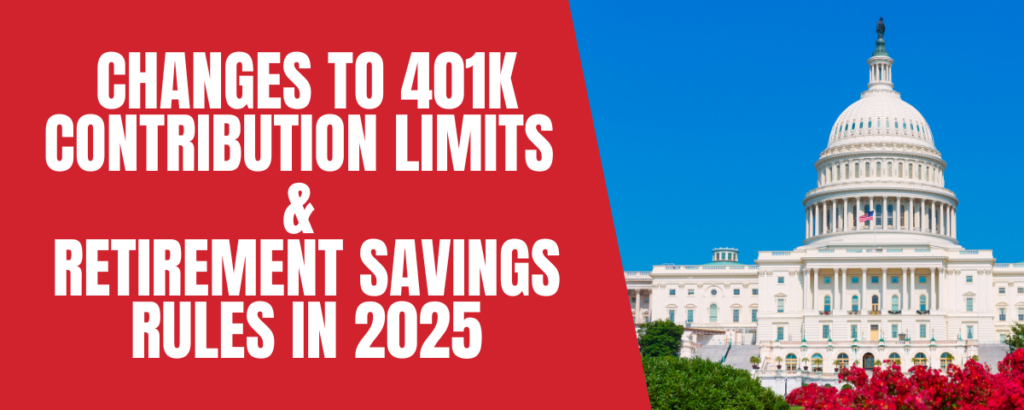
In recent years, the SECURE 2.0 Act has introduced important updates to retirement savings laws, aimed at helping Americans prepare for a financially secure retirement. With 2025 on the horizon, the latest adjustments focus on 401(k) contribution limits, new age-based provisions, and tax planning for high-income earners. These changes offer benefits to individuals of various age groups and income brackets, providing options to maximize retirement savings effectively.
Increased 401(k) Contribution Limits for 2025
Starting in 2025, the IRS has raised the annual 401(k) contribution limit to $23,500. This increase is a helpful adjustment for workers aiming to build their retirement funds, especially as financial needs have grown over the years. Individuals aged 50 and above can also take advantage of the catch-up contribution—an extra savings boost that remains at $7,500—bringing their maximum annual contribution to $31,000.
By raising these limits, the government encourages higher savings, especially for those getting closer to retirement age. Accuplan Benefits Services provides resources on maximizing these contributions and other strategies to help you achieve your retirement goals.
The New “Super Catch-Up” Provision for Ages 60-63
In addition to the regular catch-up, workers aged 60 to 63 will benefit from a unique “super catch-up” provision starting in 2025. This provision allows individuals within this age range to contribute an additional $11,250 to their 401(k) accounts, making their total possible contribution $34,750. This expanded limit offers a big opportunity for those who may need to catch up on savings, especially if they started saving later in life or faced financial setbacks along the way.
This “super catch-up” acknowledges that many Americans need to maximize savings in the years just before retirement. However, keep in mind that this option depends on your employer’s plan, so you’ll want to check if it’s offered.
Roth Requirement for High-Income Earners
Starting in 2026, high-income earners—those making over $145,000 annually—will need to make catch-up contributions to their 401(k) on a Roth basis. This means that their catch-up contributions will be made with after-tax dollars, leading to tax-free withdrawals in retirement. This change is designed to help individuals diversify their tax situation in retirement, which can be especially beneficial for high-income earners. For further details on this adjustment, visit IRS.gov.
For individuals with higher incomes, contributing on a Roth basis could lead to reduced tax burdens during retirement. If you’re unsure about whether Roth or traditional contributions are better for your situation, learning the differences can help you make adjustments to your retirement approach.
How the SECURE 2.0 Act Impacts Retirement Strategies
The SECURE 2.0 Act includes updates that impact retirement planning for individuals at various stages of life. Here’s a recap of how these changes could affect your strategy:
• Higher Contribution Limits: These updated limits provide greater flexibility to save more as retirement nears.
• Age-Specific Provisions: The “super catch-up” for those aged 60-63 allows for significant savings just before retirement.
• Tax-Optimized Savings: Roth contributions for high-income individuals support tax-free income in retirement, promoting a well-rounded tax plan.
These updates emphasize the value of creating a retirement strategy tailored to personal circumstances. For example, combining Roth and traditional contributions may offer tax advantages in retirement, while those aged 60-63 can take advantage of the super catch-up to build their nest egg.
Optimizing Your Retirement Savings with Accuplan Benefits Services
With the changes brought by the SECURE 2.0 Act, staying informed and proactive is key to successful retirement planning. Beyond 401(k) plans, Self-Directed IRAs (SDIRAs) can also provide flexible investment choices. Unlike traditional retirement accounts, SDIRAs allow you to invest in alternative assets like real estate and precious metals, which helps diversify your retirement portfolio.
If a Self-Directed IRA might align with your goals, Accuplan Benefits Services can guide you through the options and help you decide the best path for your retirement needs.
Final Thoughts on SECURE 2.0 and Your Future
The updates in the SECURE 2.0 Act reflect a move toward more flexible retirement options, supporting individuals at every stage of saving. With raised 401(k) limits, enhanced catch-up provisions, and Roth rules, retirement savers can better align their savings with their future needs.
Understanding these changes and knowing how to apply them can make a big difference in reaching your retirement goals. For more information, explore Accuplan Benefits Services for resources and insights on making the most of your retirement savings.